Published
on 12
Nov 2020
|
All rights reserved.
|
|
|

|
|
Rounder
and sleeker new Leon keeps most of its existing virtues and flaws...
|
|
This
is the 4th generation Seat Leon. Those familiar with the last 3
generations won’t be surprised by it. As always, it is built on the
same platform as Volkswagen Golf – this time the second generation MQB
platform. Also like before, it is supposed to be a sportier and cheaper
offering than its VW sibling, but at the same time less comfortable and
less expensive feeling. Compare with another sibling, Skoda Octavia, it
is less spacious and less practical, but should look far more
interesting and appeal more to younger drivers.
The new Leon does not lack style. It looks rounder and sleeker than the
last generation. There is a new hexagonal grille up front and an Alfa
Romeo-style rear end, while keeping the upward kick at the C-pillar.
Problem is, it is not distinctive enough in the seas of family hatches.
The side view is not remarkably different from what we have seen in
older Mazda 3 or Kia Cee’d. There is not a single element in its
exterior really stands out. This means you are likely to forget it a
couple of years later. If not seeing its badge, I suppose you will be
hard pressed to tell which brand it belongs to.
Compared with the Mk3, however, its exterior styling is still an
improvement in my opinion. The softer lines are easier to eyes, and a
more “cab-rearward” proportion looks more matured than the
semi-monospace shape of the old car. No, it still fails to give a false
impression of rear-wheel drive, unlike Mazda 3, but neither does it
look like a people carrier from the driver seat as its predecessor did.
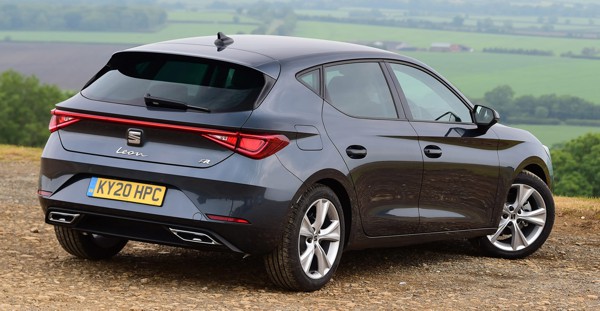
|
|
There
is some Alfa Romeo in its rear end design.
|
|
While the exterior design switches from angular to a smooth theme, the
interior styling is on the contrary. The dashboard moulding has
prominent sharp edges, and the hexagonal air vents look as if coming
straight from Lamborghini. Metallic plastics brighten the cabin a
little, but otherwise this place is dark and boring, lacking the
colorful and cheerful ambience of many modern designs. The materials
leave something to be desired, too. The use of quality soft plastics is
more restrained than the case of Volkswagen, so there are plenty of
hard plastics on show, not only at the lower half of the cabin but also
at some frequent touch points, such as door pulls.
Seat would rather spend money on electronics, which is a vast upgrade
from the old car. All but the base model gets a 10.25-inch customizable
digital instrument, while a touchscreen of the same size stands freely
at the center console. Graphical interface of the infotainment system
is less appealing than that of the Golf, but since the hardware and the
software behind the GUI are mostly the same, it responds quickly and
works intuitively. On the flipside, the touchscreen replaces many
physical knobs and buttons, so whenever you adjust the climate control
or switch radio station, you need to look at the screen and press a few
times. Sometimes technology could make easy things complicated.
However, the new cabin is larger than before. A 50-mm stretch of
wheelbase – now at 2686 mm – provides more rear legroom.
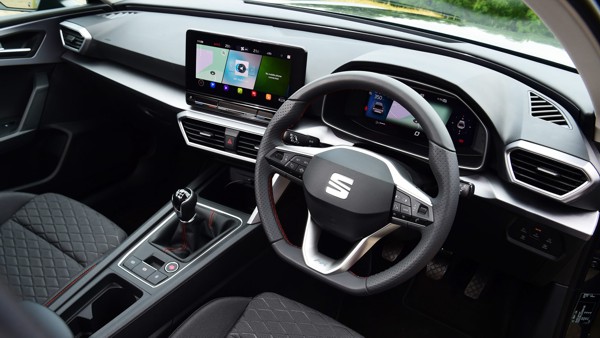
|
|
Interior
saves money for upgraded electronics.
|
|
The new Leon
is also more than 100 mm longer than its predecessor, but its frontal
area is virtually unchanged. The sleeker body reduces drag coefficient
from 0.32 to 0.29, so to help improving fuel economy.
The second generation MQB platform is not remarkably different from the
last one. There might be a slight improvement in rigidity or
insulation, but the focus is to reduce build time hence production
cost. One of the casualties is the 3-door SC model, which is no longer
offered, leaving only the 5-door hatchback and the Sportstourer wagon.
Most cars will employ a simple twist beam in rear suspension, while
multi-link setup is reserved for more powerful models. While VW Golf
receives the more sophisticated suspension for models from 150hp, Seat
lifts the threshold beyond 150hp. This means both the 150hp 1.5 TSI
petrol and 2.0 TDI diesel are settled with the cheaper rear suspension.
To save the game, FR trim lowers the suspension by 15mm, while DCC
adaptive dampers are optional.
The engine range of Leon mirrors that of the Golf as well. At the
bottom is a 1.0 TSI 3-cylinder turbo producing either 90 or 110 hp.
Higher up is a pair of 1.5 TSI 4-cylinder turbo with 130 hp or 150 hp.
The 3-pot motors and the 130 hp 1.5T SI run Miller cycle combustion,
while the 150 hp unit employs cylinder deactivation for the same
purpose. 48V mild hybrid is optional for the 110 hp and 150 hp engines,
but their usage is limited to DSG gearbox. Diesel power is diminishing,
leaving only a 2.0 TDI unit in 115 hp or 150 hp form. Instead, those
looking for economy may opt for eHybrid, which combines a 1.4 TSI
engine, electric motor, DSG box and a 13kWh Li-ion battery to produce a
system output of 204 hp, 258 lbft and an electric range of 60 km (37
miles).
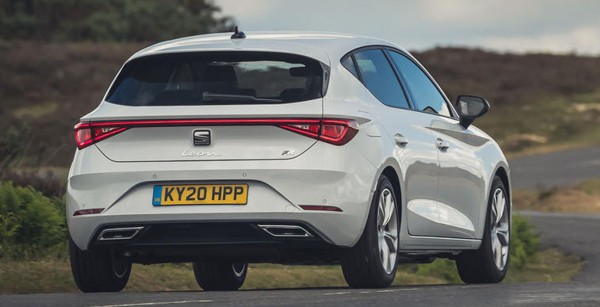
|
|
Dynamically,
it is one of the better cars to drive in its class. Just don't choose
the heavy Cupra eHybrid.
|
|
At
the top, there will be high performance Cupra models, now offer 3
powertrain choices. In hatchback and front-wheel-drive form, you can
choose between 245 hp / 273 lbft and 300 hp / 295 lbft version of the
EA888 2.0TSI engine. They are served with VAQ electronic LSD at the
front axle. For Sportstourer, there is an additional choice of 310 hp /
295 lbft version of the same engine, but mated to 4WD system with
Haldex multi-plate clutch. Meanwhile, the Cupra version of eHybrid
employs the same powerplant as the regular eHybrid, just has its output
lifted to 245 hp and 295 lbft. Besides, the Cupra also includes
necessary chassis upgrades, i.e. lower and stiffer suspension, larger
wheels, wider tires, more powerful brakes and extra aero kits.
On the road, the Leon in 1.5 TSI FR spec. shows similar dynamic
qualities as its predecessor. Due to the less sophisticated rear axle,
it rides more harshly on broken surfaces or over expansion joints than
the Golf. The noise insulation is also less effective to cut down road
and wind noise. However, it is one of the better steer of the class.
The steering is precise, linearly weighted and have a sharper response
just off center than its VW cousin. The car balances well, grips well,
corners flatly and turns in willingly. It is not as sharp to steer or
as interactive to throttle input as a Ford Focus though, and the
suspension is not as absorbent as well, but it is positive enough to
satisfy most drivers. Meanwhile, the 1.5-liter engine is smooth and
rather quiet, although there is a bit of turbo lag low down. The
6-speed manual shifts slickly, while Volkswagen’s DSG box is typically
good.
For the Cupra sub-brand, we have to leave the hottest petrol models
until they are available later. Perhaps to avoid heavy fleet emission
penalties, Seat deliberately delays them and puts the plug-in hybrid
model on sale first. Despite impressive economy and emission figures,
it is not much fun to drive. The extra 350 kg it carries blunts both
performance and handling, so it fails to live up to the expectation for
the Cupra name. Let's hope the petrol Cupra will be more excting to
drive.
|
Verdict:     |
Published
on 10
Sep 2021
|
All rights reserved.
|
|
Cupra Leon
|
|
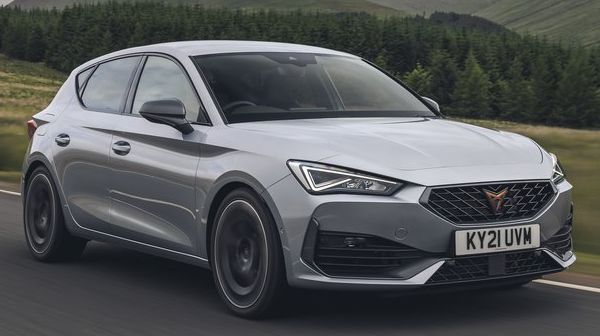
|
|
Again,
the Cupra Leon is fast and exciting to drive, but now it is also a more
accomplished package.
|
|
There are probably too
many choices in the family hot hatch segment these days. Volkswagen
Golf alone offers no fewer than 5 variants: GTI, GTD, GTE, GTI
Clubsport and R. And then its cousins from Audi, SEAT and Skoda, rivals
from Ford, Renault, Honda, Hyundai, Mercedes-AMG and BMW M, to name a
few. To distinguish one from others is not easy. You might build a
hardcore machine like Renault Megane RS Trophy-R, but then its price
and usability are far removed from mainstream buyers. Conversely,
occupying middle-of-the-road like Golf GTI is a safe choice, but you
risk yourself being challenged by all kinds of rivals. In the end, the
one achieving the best overall package at a reasonable price deserves
to succeed.
Cupra Leon might be one of those contenders for success. Since its
birth in 2001, the SEAT hot hatch has been selling as a faster,
sportier looking yet cheaper derivative of Golf GTI. Usually it
sacrificed interior, build quality and refinement to achieve the lower
prices, but this started changing in the last generation, which became
quite desirable. As Cupra is now marketed as a separate brand, it
continues climbing upmarket. While the last Leon Cupra cost
£27,000, the new Cupra Leon – officially no longer a SEAT,
although we all know who builds it – asks for £35,000, just
£2,000 less than what Volkswagen charges for a Golf GTI
Clubsport. However, we still consider the SEAT, sorry, Cupra somewhat a
bargain, because at this price it offers virtually all equipment you
want, including DSG gearbox and adaptive dampers, both of which cost
extra on the Volkswagen. Factor in a longer wheelbase, hence more
interior space, you can’t help wondering how VW can survive.
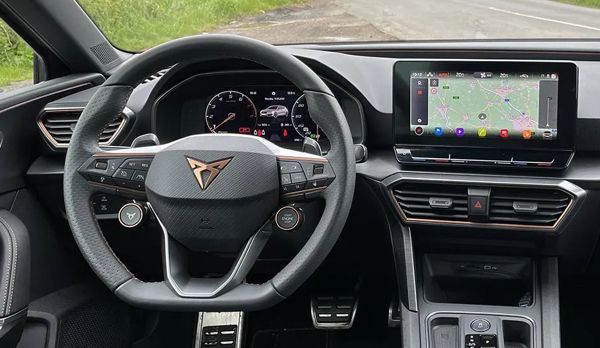
|
|
While
VW uses haptic buttons and touchscreen to alter driving
characteristics, the Cupra makes do with physical buttons on steering
wheel.
|
|
Especially as they share much the same hardware. Not only the MQB Evo
platform but also the EA888 2-liter turbo engine at exactly the same
tune – 300 horsepower and 295 pound-foot of torque. You have to admire
the vision of Volkswagen group bosses, who play fair to its various
brands, not reserving the best bits for its namesake. Let them compete
with one another and build the best products! Consequently, the Cupra
Leon is just as quick as the GTI Clubsport. Top speed is regulated at
155 mph, while 0-60 mph is claimed at 5.4 seconds – just a tenth shy of
the slightly shorter and lighter Golf. It also shares the same VAQ
electronic differential with the Golf, so that it can put down power
cleanly to the front wheels even when you push it through a tight
corner. Torque steer? There is almost none.
In fact, the tuning work done by the Spanish engineers might be better
than their German counterparts. Both the engine and DSG feel a tad more
responsive to input. The steering is lighter yet sharper. The 370mm
cross-drilled Brembo brakes standard here offer superior stopping power
and delicate pedal feel. The electronic controls are also far easier to
use. While the Volkswagen relies on haptic buttons and slider in
touchscreen control to alter its driving characteristics, the Cupra
offers physical buttons on its steering wheel. What we were not
impressed with the Volkswagen, the Cupra has answers.
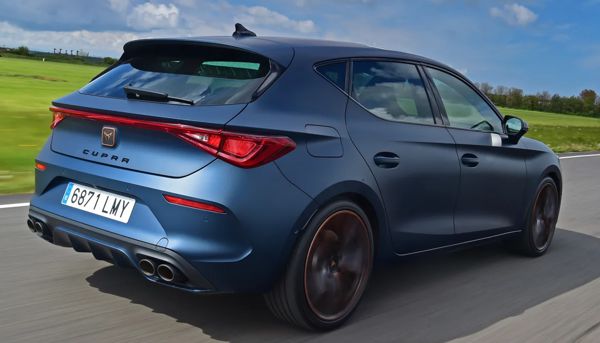
|
|
The
Cupra is better to drive than Golf GTI Clubsport.
|
|
This car is not only quick but also good to drive in every way. Grip,
traction, poise and balance are remarkable. The steering is direct and
accurate. Turn-in is pretty sharp, and the rear axle is willing to
cooperate if you call for lift-off oversteer – not quite as easily
accessible as Ford Focus ST, but it helps tightening the line anyway.
The Cupra rides comfortably enough in Comfort setting of its dampers;
Sport mode keeps cornering flat and resisting float, while Cupra mode
offers the tightest control if you can find a stretch of glass-smooth
surface. As suspension, engine, gearbox, steering and ESP are all
independently controlled, you can select whatever combinations you like
and save them.
Dynamically, it has few flaws. You might say its steering lacks tactile
feel of Honda or Ford, or the synthesized exhaust note displeases the
purists. Switch it off and you will find the EA888 a bit short of aural
character. But these can be easily forgotten in everyday driving.
To me, what the Cupra Leon still lacks is a bit more thrills from its
packaging. You will expect the Cupra brand to look more special outside
and more premium inside than the lesser SEAT Leon, not just small
spoilers, matt paint, slightly different grilles or bronze-colored
trims. Comparative, the Cupra Formentor crossover looks more special
inside and outside. But we can understand why, because the company
tries to avoid reaching the same prices as the equivalent Volkswagen.
Maybe 10 years later, when Cupra has built enough reputation, it can
command the same price as VW. Not now.
|
Verdict:     |
|